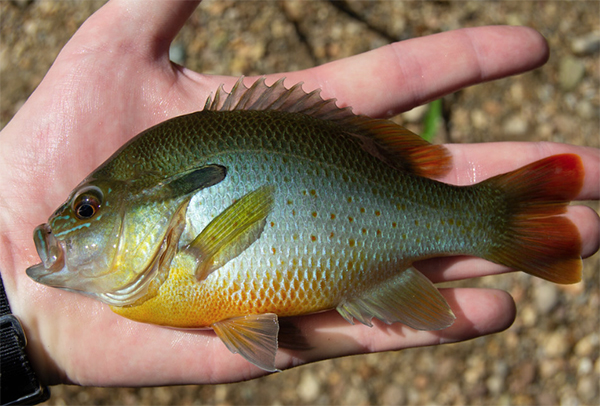Editor’s Note: This is the fourteenth article in an ongoing series about Kentucky’s gamefish species
The Redbreast Sunfish (Lepomis auritus ) is native to the Atlantic coastal states, from New Brunswick, Canada, south to Florida, but this colorful, scrappy sunfish has been introduced into several southern states, as far west as Texas.
A member of family Centrarchidae, the Redbreast Sunfish is at home in flowing rivers and creeks, and lakes fed by significant stream inflows.
The Redbreast Sunfish was the first member of the sunfish family to receive a scientific name, described in the scientific literature in 1758 by naturalist Carolus Linnaeus. Its species auritus means “eared,” because of its elongated and flexible opercular (gill) flap.
Size and Coloration
Adults are usually smaller but can grow to 8 to 10 inches long, weighing 3/4 to 1-pound.
Their mouths are small, and their bodies slab-sided. They are a slow-growing species.
Redbreast Sunfish (Photo from Flickr Commons)
Coloration is light or dark blue above the lateral line, with yellowish sides.
The breast is bright red in adult males, yellow in females.
There have wavy bright blue lines on their gill coverings, and the gill flap is solid black.
The dorsal fin typically has 10 to 11 spines.
In some waters outside of its native range, coloration may vary and anglers sometimes confuse the Redbreast Sunfish with other sunfish species.
Like all sunfish species, the Redbreast Sunfish is a spring spawner. Spawning starts when water temperatures reach 68 to 82 degrees F.
The female lays her eggs in a shallow depression in the bottom substrate of sand or fine gravel, built by the male.
She typically lays about 1,000 to 2,000 eggs, sometimes more, depending on her age. After the male fertilizes the eggs, he fans them and then guards the fry after the eggs hatch. A male sunfish may breed with more than one female.
Reproductive maturity is reached the second year of life, and male Redbreast Sunfish may live for as long as seven years.
Distribution in Kentucky
The Redbreast Sunfish is a non-native species, introduced by the Kentucky Department of Fish and Wildlife Resources (KDFWR).
They were stocked because it was believed they might tolerate low pH waters better than native sunfish species.
According to KDFWR stocking records, 982,069 Redbreast Sunfish were stocked in the state from 1969 until 1983, in eight counties in eastern and western Kentucky — in seven streams, four small lakes and two major reservoirs (Carr Creek Lake and Paintsville Lake).
It’s likely that since those initial stockings, populations have expanded, and the sunfish species may now be established in six of the state’s stream drainages.

(Photo courtesy North American Native Fish Association)
Food Habits
Adult Redbreast Sunfish feed on immature aquatic insects, snails, crayfish, and small fish.
They are preyed upon by black bass and piscivorous species of catfish, that eat only live fish.
Fishing Tips
The most effective way to catch a Redbreast Sunfish is still fishing live bait, crickets, red worms, or mealworms, on a pole or light spinning tackle.
They are usually in shallow water so take care not to spook them with large, colorful bobbers or moving the bait too much. Let the bait drift.
Redbreast sunfish can also be caught on artificial lures, casting tiny spinners or jigs on ultralight spinning tackle, or fly fishing with wet flies or bead head nymphs, which imitate aquatic insects.
The Redbreast Sunfish is a strong fighter when hooked and prized for its excellent food value, due to its sweet, flaky white flesh. A favorite way to prepare them for the table is to dip fillets or bone-in whole fish, with head and viscera removed, into seasoned batter and fry in vegetable oil in an iron skillet.
The Redbreast Sunfish is an uncommon species in Kentucky that thrives in cool, rocky streams, and is sometimes misidentified by anglers.

Credit: Source link






























